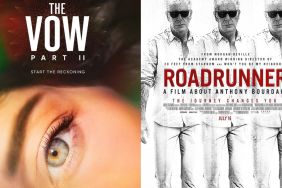At the 2008 Sundance Film Festival, Sacha Gervasi’s debut documentary Anvil! The Story of Anvil won over many attending movie and music lovers with its heartwarming (and sometimes heartbreaking) tale of Canadian metal rockers Anvil, a band who originated the speed metal sound emulated by so many other bands from Metallica and Megadeth to Slayer and Anthrax. Yet Anvil never really took off, and 25 years later, the band’s founding members, lifelong friends singer “Lips” Kudrow and drummer Robb Reiner, are still floundering in obscurity, working menial day jobs while playing the token gig at significantly smaller venues. With an offer to return to Europe and Japan for the first time in decades, things seem to be looking up for the band, and the film by Sacha Gervasi (who wrote the screenplay for Steven Spielberg’s The Terminal) follows them as they try to keep their metal dreams alive while making plans to record their 13th album.
What’s ironic about the movie is that most people seeing it find the band’s story to be inspirational, although in the movie, they don’t really end up that much further ahead than they were at the beginning. On the other hand, the interest in the movie from its festival run over the last year has generated interest among managers and labels who never would have touched the band before, who now see they’re a potentially hot commodity due to their history in the roots of metal and their clear influence on bigger bands.
ComingSoon.net attended a New York roundtable interview with “Lips,” Robb and Sacha and then afterwards, we sat down with Gervasi for the exclusive video interview that follows.
As we see early in the movie, Lips still works a number of day jobs, and he explained why it’s been important for him to do so, rather than putting all of his focus in the band. “I’ve always worked part-time for many many years, but I only worked half a day because that’s all I could afford to work and not hamper the band’s progress. I’ve been able to make whatever money I make from the band plus a part-time job, I’ve been able to acquire what most people get out of being lower middle class, which is pretty good. You get a house, a car, food on the table, you’re doing okay, and you’re able to maintain. It was a beautiful balance in a certain sense because the band would give me the freedoms to go on vacations that are completely and utterly paid for, and it is a vacation, because you’re not doing what you do normally. Let’s say there’s 30 days out of the month, and you’re going to rehearsal and writing songs and working. Now, you get to just go out and have fun and play. You do that every three or four months for a couple of week stints. What a great balance. At least you have that to look forward to, even though I’m doing these horrible deliveries.”
“I’m an artist, I paint a lot,” drummer Robb Reiner responded when asked about his own non-rockin’ hobbies, “and I own a construction renovation company.”
The film opens with interviews with some of the biggest names in metal talking about their love for Anvil and its music, and Gervasi explained how those came about. “I was one of those group of two or three hundred people in London who was completely into the Anvil thing when it was happening in ’82, ’83, ’84. As it turns out, there were other people in America also experiencing the same thing because they would look to the new wave of heavy metal, those guys, so there was going to be a few hundred people around America who were into it, too. It just so happens that those people went on to become some of the famous bands in thrash metal. As I was writing the cover of “Sounds” in ’82 with him on the front cover, so was Lars Ulrich, so was Scott Ian. Scott Ian told me that Anthrax began as an Anvil cover band. They would start rehearsing six nights a week rehearsing all the songs on “Metal on Metal.” It’s just this small pocket that only a few people really knew about, but it just so happens it’s those people. When the word got out when we were going to make the film, it was amazing. I thought it would be so hard to get the people, but it wasn’t. When Scott Ian found out, he was just fantastic, and Lars was amazing. We sit down and Lars would not stop for nearly 40 minutes, just went on and on about how amazing the band was, how influential they are. What was amazing was his desire, as someone who’s in probably the biggest heavy metal band in the world right now, to really give this band the respect he felt they deserved.”

Now that the band is getting a lot of interest from labels, there’s more of a chance you’ll see them on tour and playing the big rock festivals who’ve ignored them for decades, though anyone who sees the film without reading this might not even believe it’s a real band, since they had been in obscurity for so long. Gervasi wasn’t too worried about the band’s plight being compared to one of the more famous mockumentaries, This is Spinal Tap.
“I knew that people wouldn’t believe it,” the director admitted. “When my crew was thinking that it wasn’t real, I knew we had something. If my own crew thinks I’m playing a joke on them, then the audience is going to feel this can’t be real. I encouraged that. Remember in ‘Spinal Tap’ when David and Nigel talk about writing their first song, they shoot it in the diner, so I thought that I was going to shoot when they talk about their first song in a diner, and then I ask, ‘What was your first song?’ and they come out with ‘Thumb Hang’ about the Spanish Inquisition, which I’d never even heard. My job was sort of to press record all the time and then sort out the narrative structure in the edit, but the truth is that the moment I met them again, it was like a walking film.”
Lips wasn’t too worried either. “I’m a big fan of Spinal Tap and even stuff that’s probably obscure to most American audiences like ‘The Bad News Tour’ which is something that was taken from a program called ‘The Young Ones’ in the UK, which was actually the original Spinal Tap.”
The three guys also talked about having the cameras in the studio during some of the toughest struggles they faced as a band, moments in the film reminiscent of the documentary Metallica: Some Kind of Monster from a few years back.
“What could be a better way to exemplify a relationship than showing a breakdown and getting over it?” Lips asked us. “Nothing could demonstrate that better. During it, I couldn’t care less if the cameras were running, but in the back of my mind, I realized that this could be really important, but at the same time, I didn’t care. Stuff had to be said to my friend. I just blew up at him, and even though there was this obstacle of other people in the room, I had to get over this hurdle. I had to make things right.”
“The thing is when you have cameras around for that long, for the first hour you’re putting on a performance, but over two years, you just don’t have the energy,” Sacha explained.
“You just stop caring and you start realizing, even if it’s running, he’ll never use it,” Lips agreed.
Robb didn’t seem too disturbed by the footage of him and Lips fighting that was kept in the movie. “Also remember that in our whole friendship, we’ve only had maybe a half a dozen fallouts like that…”
“And I just happened to catch three,” Sacha joked.
And now here’s our later interview with Gervasi talking about his transition from Hollywood screenwriter to rock doc filmmaker. Besides Anvil!, we also discussed his biopic of actor Herve Villachez, which is now in pre-production to start shooting some time in the Fall.
Anvil! The Story of Anvil opens in select cities on Friday, April 10.









